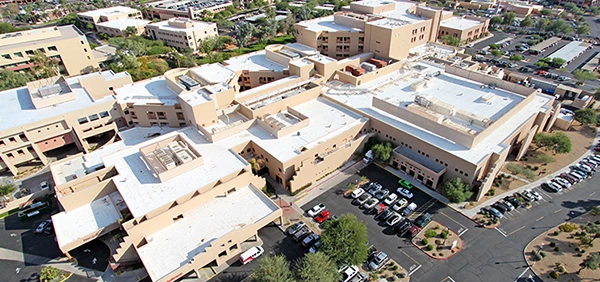#AskCentiMarkSeries: How-To Deliver Safe, Durable Roofing for Critical Healthcare Facilities.

Hey there, it’s Anne Serzz! As you know, healthcare facilities require a roofing system that not only keeps patients, staff and operations protected but also meets strict codes, cleaning requirements and the needs of sensitive medical equipment. Managing these critical environments can be tough, this blog is your prescription to success!
Today, I’m excited to introduce two of CentiMark’s roofing pros in the healthcare industry: James Elrick, National Account Manager and Gary Moore, Vice President of Sales for our Northern Group. They have the inside scoop on how to ensure these essential spaces remain safe, functional and compliant through roofing. Let’s dive right in:
Q: Maintaining a clean and sanitary environment 24/7 is paramount in the healthcare industry. How do you take this into account when building roofing solutions for healthcare facilities?
James: We carefully plan out the entire project in advance to avoid any contamination. When accessing the roof, sometimes we need to use external stairways or scaffolding. We may even require our crews to use extra precautions like booties, gloves or even lab coats to prevent contaminants from making their way into the facility.
Gary: Exactly! In this industry, there are patients, staff, visitors, maintenance personnel and more nearby, making sure everyone feels safe and comfortable during the roofing work is crucial.
Q: How does CentiMark manage roofing projects in healthcare facilities to prevent noise, odors, damaged equipment and overall disruptions to their operations?
James: We always do our best to work around their operations which requires detailed planning and communication. With CentiMark, we are always transparent on what to expect when it comes to inconvenience and also incorporate signage so everyone knows work is being done. A pre-job meeting with the CEO, CFO, administrators, director of plant operations and even the maintenance staff ensures everyone's on the same page.
Gary: That’s right. Hospitals usually have patients on-site 24/7, which makes certain tasks tricky. For example, we may opt for adhesives over loud fasteners when installing a commercial roof to minimize noise. However, these adhesives may bring the challenge of odors. Our team can use low-odor, low-VOC adhesives and additional ventilation systems, like charcoal filters, to help minimize the odor and impact on air quality when conducting our roofing work!
Q: How can CentiMark help healthcare facilities comply with strict codes, insurance requirements and Joint Commission Inspections?
James: When it comes to codes and insurance, meeting the specific requirements for each project is a necessity. When conducting roofing work in healthcare facilities, we typically see background checks, vaccinations requirements and working around possible language barriers that could limit the contact between our workers and the hospital personnel. Therefore, for critical industries like these, we usually provide additional staff training to make sure we’re well-equipped for the job. As for Joint Commission Inspections, we typically visit a property a week or two in advance to look for leaks, make sure everything is tidy and address any issues before they become problems.
Gary: The location of your facility plays a huge role in all of these too. When it comes to insurance, such as FM Global, you need to meet specific requirements like wind uplift and R-value insulation standards. So in Florida, hospitals in hurricane-prone areas often have to meet stringent codes, like Miami-Dade standards, which require extra measures to withstand severe weather.
Q: Can you share a challenging roofing project you’ve worked on for a healthcare facility and how you managed it?
Gary: One particularly challenging project was at a hospital in Ohio where they were conducting sleep studies. Being noisy wasn’t an option during the roofing project, so the timing of our work was critical - we had to work carefully around their operations and hours. We’re very flexible at CentiMark, so we worked closely with the hospital’s personnel to accommodate their schedules and ensure the project was completed efficiently and without disruption.
Overall, when it comes to roofing for healthcare facilities, it’s all about being patient while we take the roofing work off of your plate (see what we did there?). Working with the right contractor, like CentiMark, that can seamlessly balance safety, durability and compliance while minimizing disruptions is a game-changer. We’ve got the knowledge, bandwidth and flexibility to meet the unique roofing challenges in this critical industry. Whether it’s keeping things squeaky clean or working quietly under the radar, we’re here to ensure your facility remains functional for years to come.
About our Panel:
James Elerick:
With 30 years of experience, he has worn many hats over the years and is equipped with extensive commercial roofing knowledge! From starting on the roof to becoming a well-polished National Accounts Manager, he has done roofing work for many different facilities including various large-scale hospitals.
Gary Moore:
Gary has been in the roofing industry for over 22 years. He has also had hands-on experience working with various healthcare institutions over the years. He understands the importance of handling roofing projects right and is dedicated to providing solutions to help you manage your healthcare facility with ease.
When you subscribe to the blog, we will send you an e-mail when there are new updates on the site so you wouldn't miss them.
